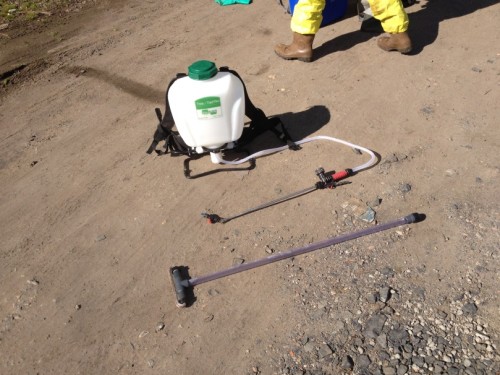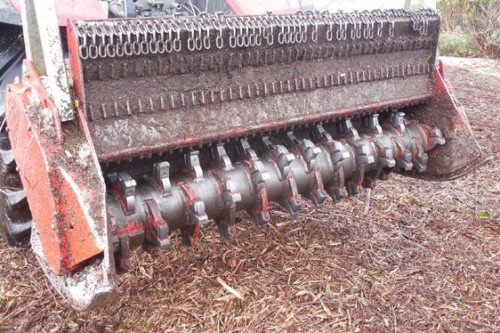Before treating Giant Hogweed great consideration should be given to the health and safety aspect, from working on a small immature bush in your back garden to a huge stand covering waste ground. The sap of Giant Hogweed is poisonous and just brushing up against the plant can have severe consequences.
All bare skin should be covered up, depending on the size of the plants face protection may be required, equipment should be cleaned and inspected for seeds after use to avoid transporting them to a location which doesn’t yet contain the plant, and wash hands thoroughly with soap and warm water after treatment. Seek medical advice if your skin has been exposed to the sap and starts to rash or blister.
The best Treatments available are herbicide application, physical destruction, on site burial and off site disposal.
Herbicides
Applied either by a sprayer, stem injection or weed wiper. In reality weed wiping is only going to be practical on small stands where conditions preclude spraying and the plants are too small for stem injection but it is an option
It’s best to apply herbicide in early to mid-spring, applying on dry, windless days is highly effective. The herbicide needs to stay on the surface of the plant for a sufficient amount of time to penetrate into the plant. Follow up applications may be required, particularly on dense stands where access is poor as small seedlings which were inaccessible under the leaf cover of larger plants may have germinated after the initial treatment.

The sprayer operator must have relevant qualifications in the safe handling and use of pesticides and relevant applicator. All regulations and conditions of the herbicide product label must be adhered too. If timed correctly and done properly herbicide application will kill all live Hogweed within the target area but it will not impact upon dormant seeds. Therefore treatment over the next 2 to 3 growing seasons will be required.
Physical Destruction
It is possible to eradicate Giant Hogweed through physical destruction of the plant itself. This can be achieved on a small scale by using a sharp spade and digging through the central root of the plant. If you severe it completely and cause enough damage it is possible to kill the plant this way. It’s laborious and you need to get right in amongst the plants to do this so protective clothing is essential. The plant should then be pulled out of the ground and left to dry out, any additional damage which is caused at this stage will only help. This will take several seasons of treatment to achieve clearance of the area.
Mechanical cutting or flailing can be effective but repeated treatments are needed throughout a growing season and care must be taken to avoid exposing workers or bystanders to sap.

Grazing can also be a cheap and effective method of control (assuming that you have livestock available) but it must be done carefully to ensure that livestock are not adversely affected and it is successful.
On site burial
Working in conjunction with herbicides or as a stand-alone option, the Giant Hogweed can be dug up and buried. Permission must be sought from the EA or SEPA to ensure that this allowable and if treated prior to burial it must be with a non-residual herbicide which will not pose a risk to groundwater. It is crucial that all seeds are included is this method is to be successful. Giant Hogweed plants and seeds must be buried at least 1m below finished ground level. Careful consideration must be given to the burial site location because it should remain undisturbed for the next 15 years or more. Protection from flooding, excavation by people or animals and accurate recording of the location are all essential for the long term success of this option. So away from service runs or other areas which may require excavation is recommended, below car parks or amenity areas are often ideal. There is no requirement to wrap the material in a membrane but some kind of visible physical barrier can be useful to deter future excavation and the location must be accurately recorded for future site users.
Off site disposal
Generally this is the quickest but most expensive option. The Giant Hogweed including all seeds and surrounding soil are taken to an appropriately licensed disposal facility to be dealt with. Around 95% of seeds will be located in the upper 50mm of soil so any excavation to remove/destroy mature plants which will need to minimally go down to around 100mm below ground surface should also remove virtually all seeds. It will be necessary to collect soils from some distance out with the immediate area of the plants to ensure that all of the seeds are excavated.
2021
Giant Hogweed removal
Accurately identifying an invasive weed without any prior knowledge can be tricky for the lesser green fingered amongst us, especially when there is a health risk involved. This free eBook will help educate, identify, treat and address the dangers of Giant Hogweed.


